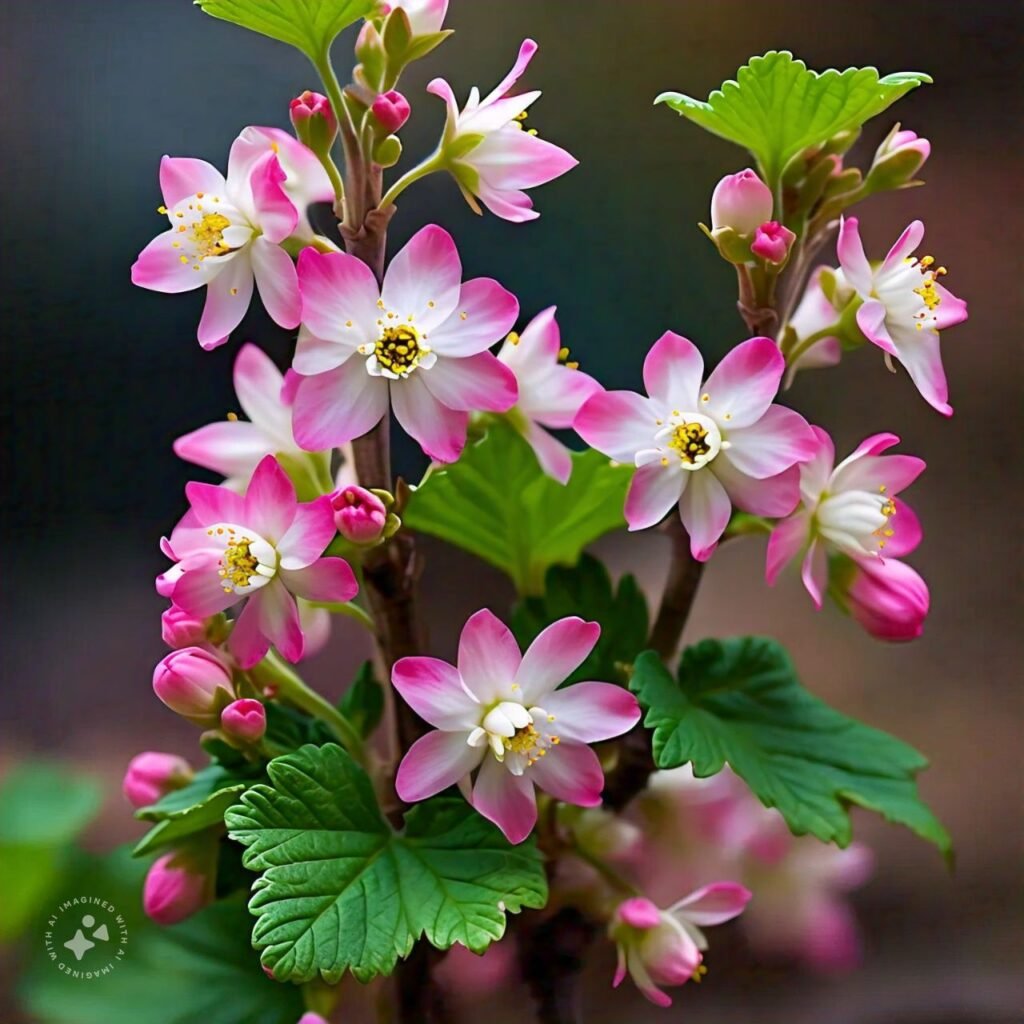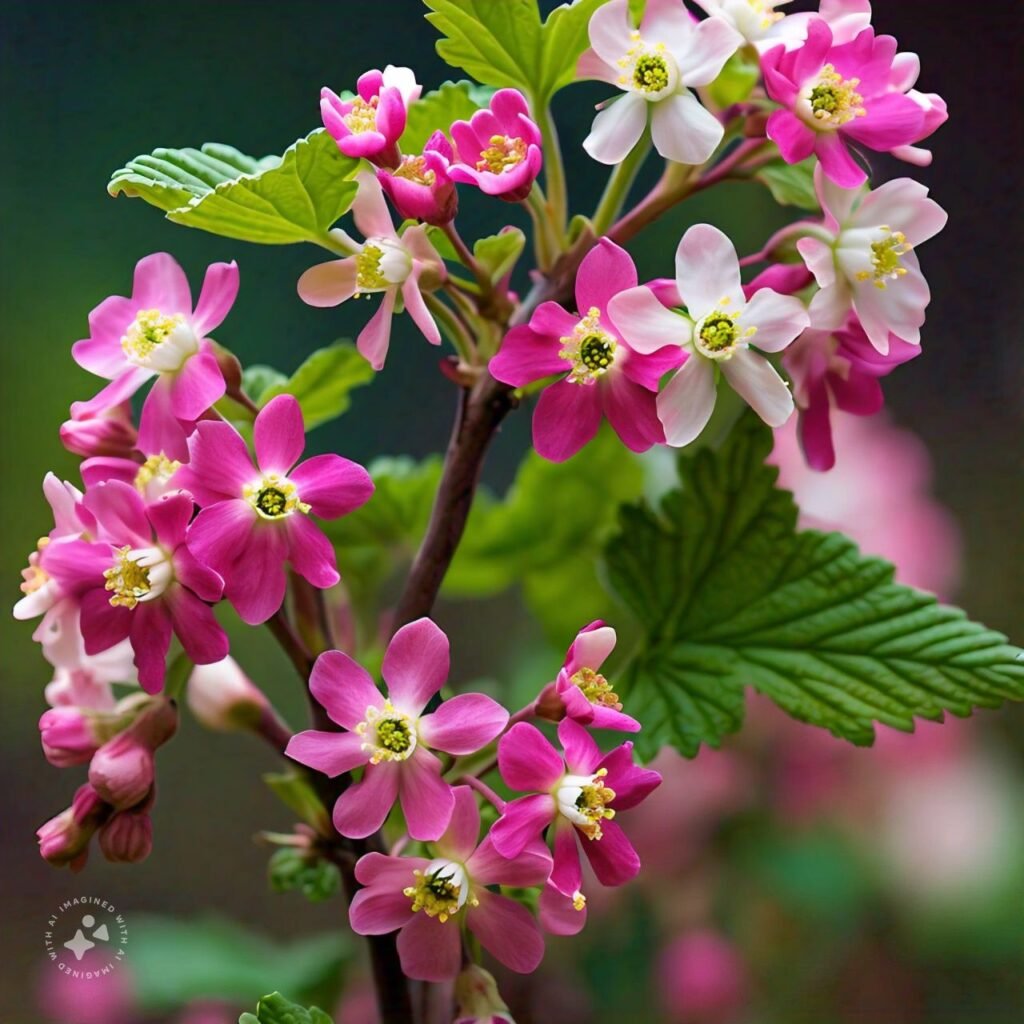
Botanical Name: The Flowering Currant is botanically known as Ribes sanguineum.
Native Habitat: It is native to the western coastal regions of North America, from California to British Columbia.
Early Spring Blooms: This plant is one of the first to bloom in early spring, providing a splash of color when most other plants are still dormant.
Flower Colors: The flowers range in color from deep red to pink and even white, depending on the variety.
Attracts Pollinators: The Flowering Currant is known for attracting hummingbirds, bees, and butterflies, making it a valuable plant for pollinator gardens.
Edible Berries: The plant produces small, dark blue to black berries that are edible, though they are often considered too tart for fresh eating.
Deciduous Shrub: It is a deciduous shrub, meaning it loses its leaves in the fall and regrows them in the spring.
Height and Spread: The shrub typically grows to a height and spread of 6-10 feet, making it a substantial addition to any garden.
Fragrant Leaves: The leaves of the Flowering Currant have a distinct, pleasant fragrance when crushed.
Drought Tolerant: Once established, the Flowering Currant is quite drought-tolerant, making it suitable for xeriscaping.
Shade Tolerant: This plant can tolerate partial shade, though it flowers best in full sun.
Easy to Grow: It is relatively easy to grow and requires minimal maintenance, making it a popular choice for both novice and experienced gardeners.

Historical Uses: Native American tribes have historically used the berries for food and the leaves and bark for medicinal purposes.

Deer Resistant: The Flowering Currant is generally resistant to deer, making it a good choice for gardens in areas with high deer populations.
Wildlife Shelter: In addition to attracting pollinators, the dense foliage provides shelter for small birds and other wildlife.Adaptable to Soil Types: The Flowering Currant can thrive in various soil types, including clay, loam, and sandy soils, as long as they are well-drained.
Frost Hardy: It is frost hardy and can withstand cold temperatures, making it suitable for gardens in cooler climates.
Pruning: Pruning is usually only necessary to remove dead or damaged wood, or to shape the plant, and is best done immediately after flowering.
Pest Resistant: The plant is generally pest resistant and not prone to serious diseases, contributing to its low-maintenance appeal.
Wildlife Food Source: The berries serve as an important food source for birds and small mammals in late summer and fall.
Cultural Significance: In some cultures, the blooming of Flowering Currant is a herald of spring and is celebrated as a sign of the changing seasons.
Landscaping Uses: It is often used in hedges, borders, and as a focal point in garden designs due to its vibrant flowers and attractive form.
Propagation: Flowering Currant can be easily propagated from cuttings or by layering, making it a cost-effective plant to share and spread.
Historical Gardens: It has been a popular choice in historical gardens and estate plantings since its introduction to Europe in the early 19th century.

Garden Companions: It pairs well with other early spring bloomers like daffodils and primroses, creating a colorful and lively garden display.

Environmental Benefits: The plant contributes to soil stabilization on slopes and helps prevent erosion with its root system.
Longevity: Flowering Currant shrubs can live for several decades with proper care, providing long-term beauty and ecological benefits.
Wildlife Habitat Restoration: It is used in wildlife habitat restoration projects to reintroduce native plant species and support local ecosystems.
Historical Medicinal Use: Some Native American tribes used the plant for medicinal purposes, such as treating colds and sore throats.
Vibrant Fall Foliage: In addition to its beautiful spring flowers, the plant’s foliage often turns attractive shades of yellow and red in the fall, adding seasonal interest.
Hybrid Varieties: There are several hybrid varieties of Flowering Currant that have been developed for different flower colors and plant sizes, adding diversity to garden choices.
Symbolism: In some cultures, the Flowering Currant symbolizes renewal and new beginnings due to its early spring bloom.
Historical Introduction: The plant was introduced to Europe in the early 19th century by Scottish botanist David Douglas, and it quickly became popular in British gardens.
Pollination Role: It plays a crucial role in the early spring ecosystem by providing one of the first food sources for emerging pollinators.

Diverse Ecosystem Support: By supporting a variety of insects, birds, and small mammals, the Flowering Currant contributes to a diverse and healthy garden ecosystem.

Wildlife Observation: Gardeners who plant Flowering Currant often enjoy increased opportunities for wildlife observation, particularly birdwatching.
Compact Varieties: Some varieties are more compact, growing only 3-4 feet tall, making them suitable for small gardens and container planting.
Historical Preservation: Flowering Currant is often included in the restoration of historical gardens to preserve the authenticity of period plantings.
Natural Dye: The berries of some species of currant plants have been used historically to produce natural dyes.
Culinary Uses: Although tart, the berries can be used to make jams, jellies, and sauces, often mixed with sweeter fruits to balance the flavor.
Educational Plant: It is often used in educational gardens and nature centers to teach about native plants and their role in local ecosystems.
Climate Adaptation: The plant is adaptable to various climates and can thrive in both coastal and inland environments, from moist to relatively dry conditions.
Cultural Celebrations: In some regions, festivals and events celebrate the blooming of the Flowering Currant as a signal of spring’s arrival.
Companion Planting: It works well with other native plants, creating a harmonious and supportive planting scheme that benefits all species involved.

Water-wise Gardening: Due to its drought tolerance, Flowering Currant is an excellent choice for water-wise or xeriscape gardens.

Firewise Landscaping: The plant is sometimes included in firewise landscaping due to its relatively low flammability compared to other shrubs.
Aromatic Appeal: In addition to fragrant leaves, some varieties have flowers that emit a light, pleasant scent, enhancing the sensory experience of the garden.
Seasonal Interest: With its early blooms, vibrant summer foliage, and colorful fall leaves, the Flowering Currant provides multi-season interest in gardens.
Cultural Resilience: It has shown resilience to changing garden trends and continues to be a popular plant choice among modern gardeners.
Low Allergen: The plant is considered low allergen, making it a good choice for gardeners with allergies or those designing allergy-friendly landscapes.
Frost Flowers: The flowers of the Flowering Currant are sometimes referred to as “frost flowers” due to their ability to bloom even in early spring frosts.
Woodland Gardens: It is an excellent plant for woodland gardens, where it can thrive under the dappled shade of larger trees.
Bee-friendly: The nectar-rich flowers are particularly beneficial for early-season bees, providing essential food after winter.

Erosion Control: Its extensive root system helps stabilize soil, making it useful for controlling erosion on slopes and hillsides.

Disease Resistance: Flowering Currant is generally resistant to common plant diseases, contributing to its hardiness.
Butterfly Host Plant: Some butterfly species use the plant as a host for their larvae, making it an integral part of their life cycle.
Heritage Gardens: It is often planted in heritage or heirloom gardens to maintain historical plant collections and biodiversity.
Pollution Tolerance: The plant is somewhat tolerant of urban pollution, making it suitable for city gardens and parks.
Autumn Berries: The berries persist into the autumn, providing a late-season food source for wildlife.
Landscape Versatility: It can be used in a variety of landscape designs, including naturalistic plantings, cottage gardens, and mixed borders.
Rain Gardens: Flowering Currant is suitable for rain gardens due to its ability to handle occasional flooding and wet soil conditions.
Folk Medicine: In addition to traditional uses, it has been used in folk medicine for various ailments, highlighting its historical medicinal importance.
Windbreaks: It can be used as part of a windbreak due to its dense growth, helping to protect more delicate plants in the garden.

Educational Tool: The plant is often used in educational programs to teach about native plant species and their ecological roles.

Garden Therapy: Its sensory appeal and low maintenance make it a good choice for therapeutic gardens designed for relaxation and well-being.
Seasonal Markers: Flowering Currant blooms are often used as seasonal markers in phenological studies to track the timing of natural events.
Biodiversity Support: By planting Flowering Currant, gardeners contribute to local biodiversity, supporting a range of species from insects to birds.
Cut Flowers: The flowering branches can be used in cut flower arrangements, adding a touch of spring beauty indoors.
Regional Adaptation: Different varieties of Flowering Currant are adapted to various regions, from coastal to inland areas, providing versatility in planting choices.
Low-input Gardening: It requires minimal inputs in terms of water, fertilizer, and pest control, aligning with sustainable gardening practices.
Eco-friendly Choice: By planting native species like Flowering Currant, gardeners promote eco-friendly landscaping and reduce the need for chemical interventions.
Legacy Planting: Given its longevity, planting a Flowering Currant can be a way to create a lasting legacy in a garden, providing beauty and ecological benefits for years to come.
Survival Skills: Its ability to survive in diverse conditions, from drought to partial shade, makes it a resilient choice for challenging gardening situations.
Ecological Indicator: The presence of healthy Flowering Currant populations can indicate a well-balanced ecosystem, as it supports a range of wildlife and pollinators.
Cultural Adaptations: The plant has adapted to various cultural practices, from formal garden settings to wild, naturalistic plantings, demonstrating its versatility and enduring appeal. Bird Watching: Planting Flowering Currant in your garden can enhance bird watching opportunities as birds are attracted to its berries and dense foliage.

Shade Garden Highlight: It adds a pop of color to shade gardens, which can often be dominated by green foliage.
Groundwater Recharge: Its deep roots can help in groundwater recharge by allowing water to penetrate deeply into the soil.
Minimal Fertilizer Needs: The plant typically requires little to no fertilizer, which reduces garden maintenance and environmental impact.
Historical Trade: In the 19th century, Flowering Currant was a valuable plant in the horticultural trade between North America and Europe.
Climate Change Indicator: Its bloom times are studied to understand the impacts of climate change on plant phenology.
Cultural Integration: Flowering Currant has been integrated into traditional garden designs across various cultures, showcasing its global appeal.
Symbiotic Relationships: The plant forms symbiotic relationships with soil microorganisms, enhancing soil health and plant vitality.
Natural Mulch: Its fallen leaves create a natural mulch that helps retain soil moisture and suppress weeds.
Winter Interest: Even in winter, its bare branches can add structural interest to the garden landscape.
Wildlife Corridors: When planted alongside other native species, it helps create wildlife corridors, aiding in the movement and survival of various species.
Hedgerow Component: It is a valuable component of hedgerows, providing food and shelter for wildlife while serving as a windbreak and privacy screen.
Ornamental Appeal: Its ornamental appeal makes it a favorite in both public and private gardens, parks, and nature reserves.
Community Planting Projects: It is often chosen for community planting projects due to its ease of growth and ecological benefits.
Low Allergen: As a low-allergen plant, it is suitable for gardens where people with allergies frequently visit.
Tolerant of Poor Soils: The plant is tolerant of poor soils, making it a good option for areas where soil quality is an issue.
Legacy Gardens: Often planted in legacy gardens, it can provide multi-generational beauty and benefits.
Erosion Prevention: Its robust root system is effective in preventing soil erosion, especially on slopes and in areas prone to runoff.
Wildlife Food Source: Provides a crucial food source for wildlife during the transition from winter to spring.
Historic Landscape: Included in historic landscape restorations to maintain the authenticity and integrity of heritage sites.
Pioneer Species: Acts as a pioneer species in reforestation projects, helping to establish a plant community in disturbed areas.
Stress Tolerance: Known for its tolerance to environmental stressors such as drought and poor soil, making it a hardy garden choice.
Aesthetic Versatility: Its aesthetic versatility allows it to fit into various garden styles, from formal to wild gardens.
Low Water Needs: Suitable for low-water gardens and xeriscaping, conserving water while providing beauty.
Beneficial Insects: Attracts beneficial insects that help control garden pests, promoting a healthy garden ecosystem. Layered Planting: Works well in layered planting designs, adding height and depth to garden compositions.
Disease Indicator: Its health can indicate overall garden health, as it’s sensitive to significant environmental changes.
Compact Varieties for Small Spaces: Some compact varieties are perfect for small gardens, patios, and urban spaces.
Herbal Use: Traditionally used in herbal remedies for its purported health benefits, though more research is needed.
Heritage Preservation: Helps preserve the natural heritage of regions where it is native, supporting local biodiversity.
Intercropping: Can be used in intercropping systems with other plants to maximize space and resources in a garden.
Sustainable Gardening: Promotes sustainable gardening practices by reducing the need for chemical inputs.
Wildflower Gardens: A beautiful addition to wildflower gardens, blending seamlessly with other native plants.
Educational Gardens: Often used in school and educational gardens to teach children about native plants and ecology.
Community Resilience: Planting native species like Flowering Currant helps build community resilience against environmental changes.
Low-maintenance Landscaping: Ideal for low-maintenance landscaping, requiring minimal care once established.
Visual Focal Point: Its vibrant flowers and colorful fall foliage make it an eye-catching focal point in garden designs.
Wind Tolerance: Can withstand windy conditions, making it suitable for exposed garden sites.
Companion to Spring Bulbs: Pairs well with spring bulbs like tulips and daffodils, enhancing early season color.
Natural Fertilizer: Its fallen leaves enrich the soil as they decompose, acting as a natural fertilizer.
Health Benefits: The berries are high in vitamin C and antioxidants, though they are often too tart to eat fresh.
Cultural History: Rich in cultural history, having been used by Native Americans for food, medicine, and ceremonies.
Seasonal Transitions: Marks seasonal transitions in gardens, providing early spring blooms and late fall berries.
Multi-purpose Plant: Serves multiple purposes in the garden, from aesthetic beauty to ecological benefits.
Climate Adaptability: Demonstrates a high level of adaptability to various climates, thriving in different regions. Pollinator Corridor: Plays a key role in creating pollinator corridors, essential for the migration and survival of many pollinator species.
Winter Shelter: Provides winter shelter for small animals and birds, enhancing garden biodiversity.
Versatile Growth Habit: Its versatile growth habit allows it to be trained as a hedge, stand-alone shrub, or incorporated into mixed borders.
Urban Planting: Suitable for urban planting schemes, where it can help mitigate pollution and provide green spaces.
Wildlife Observation: Planting it near windows or patios can provide excellent opportunities for observing wildlife up close.
Aromatic Benefits: The aromatic leaves and flowers can enhance the sensory experience in a garden.
Natural Fertilizer Source: Its fallen leaves improve soil structure and fertility as they decompose, adding organic matter to the soil.
Seasonal Color: Offers a succession of colors through the seasons, from vibrant flowers in spring to colorful foliage in fall.
Bird Nesting Site: Provides a secure site for bird nesting, increasing the chances of successful breeding for local bird species.
Landscape Diversity: Adds to the diversity of plant life in landscapes, which is crucial for maintaining ecological balance.
Scented Flowers: Some varieties produce lightly scented flowers, which can add an extra sensory dimension to gardens.
Garden Borders: Works well as a border plant, adding height and structure to garden edges.
Drought Resistance: Its drought resistance makes it an ideal choice for gardens in arid regions or areas with water restrictions.
Wildlife Gardening: An excellent plant for wildlife gardening, encouraging the presence of beneficial insects and animals.
Symbol of Spring: Often seen as a symbol of spring, signaling the end of winter and the return of warmer weather.
Historical Popularity: Remains popular in gardens due to its historical significance and enduring appeal.
Medicinal Research: Ongoing research into its medicinal properties could unlock new uses for this versatile plant.
Ecosystem Restoration: Used in ecosystem restoration projects to reintroduce native flora and support local wildlife.
Educational Value: Provides educational value by demonstrating plant-pollinator interactions and native plant importance.
Multi-season Interest: Provides multi-season interest with its spring blooms, summer berries, and fall foliage.
Heirloom Gardens: A favorite in heirloom gardens due to its long history of cultivation and use.
Natural Dye Source: Historically, its berries have been used as a natural dye source for textiles.
Water Conservation: Its low water needs contribute to water conservation efforts in landscaping.
Beneficial Companion Plant: Acts as a beneficial companion plant, supporting the health and growth of surrounding plants.
Fire Adaptation: Can recover well from fire, making it a resilient choice for fire-prone areas.
Seasonal Markers: Used by gardeners and naturalists as seasonal markers to track the progression of the year.
Nutrient Cycling: Contributes to nutrient cycling in the garden ecosystem by breaking down organic matter.
Native Plant Sales: Popular in native plant sales and exchanges, encouraging the use of local flora.
Cultural Practices: Integrated into various cultural practices and celebrations, showcasing its wide-ranging significance.
Longevity in Gardens: Its long lifespan ensures it remains a fixture in gardens for many years, providing continuous benefits. Therapeutic Horticulture: Used in therapeutic horticulture for its calming presence and easy maintenance, benefiting mental health.
Urban Heat Island Mitigation: Helps mitigate the urban heat island effect by providing shade and cooling through transpiration.
Pioneering Species: Functions as a pioneering species in disturbed areas, helping to prepare the ground for other plants.
Insectary Plant: Acts as an insectary plant by providing habitat and nectar for beneficial insects that control pests.
Diverse Cultivars: Numerous cultivars with varying flower colors and growth habits cater to different garden preferences.
Historical Gardens Preservation: Plays a role in preserving historical gardens, maintaining authenticity and heritage.
Windbreak Uses: Effective as a windbreak, protecting more delicate plants from harsh winds.
Autumn Berries for Birds: The berries serve as an important food source for birds during autumn, supporting migratory species.
Cultural Landscape: Integral to the cultural landscape of regions where it is native, symbolizing natural heritage.
Aesthetic Diversity: Its aesthetic diversity allows it to fit into formal, informal, and naturalistic garden designs.
Rain Garden Component: Suitable for rain gardens due to its ability to handle occasional flooding and improve water infiltration.
Minimal Pesticide Use: Requires minimal pesticide use, promoting a healthier garden environment.
Fragrance in Shade: Adds fragrance to shaded areas, where other flowering plants might not thrive.
Layering Technique: Can be propagated through layering, making it easy to expand its presence in the garden.
Nutrient-Rich Leaves: Fallen leaves contribute to soil fertility by adding nutrients as they decompose.
Ecosystem Services: Provides numerous ecosystem services, including pollination, erosion control, and habitat provision.
Wildlife Connectivity: Enhances wildlife connectivity in fragmented landscapes by serving as a habitat corridor.
Biocultural Diversity: Represents biocultural diversity by linking natural and cultural heritage.
Early Spring Color: One of the first plants to provide color in the garden, brightening up early spring days.
Nature Observation: Facilitates nature observation, offering opportunities to study plant-pollinator interactions.
Gardening Traditions: Embedded in gardening traditions, passed down through generations of gardeners.
Pollinator Habitat Restoration: Used in pollinator habitat restoration projects to support declining pollinator populations.
Climate Change Resilience: Demonstrates resilience to climate change by thriving in a range of conditions.
Shade Tolerance: Tolerates shade, making it versatile for different garden spots.
Visual Interest in Winter: Provides visual interest in winter with its bare branches and textured bark.
Wildlife Habitat Enrichment: Enriches wildlife habitats by offering food, shelter, and nesting sites.
Educational Resource: Serves as an educational resource in botanic gardens and nature centers.
Historical Botanical Studies: Studied in historical botanical research for its role in plant introductions and horticulture.
Firewise Landscaping: Used in firewise landscaping for its relatively low flammability and quick recovery.
Restoration Ecology: Important in restoration ecology for reestablishing native plant communities.
Bird-Friendly Gardens: An essential plant for bird-friendly gardens, supporting avian biodiversity.
Garden Clubs: Popular among garden clubs for its beauty and ecological value.
Cottage Gardens: Fits well into cottage garden designs, adding charm and color.
Environmental Education: Used in environmental education programs to teach about native plants and ecosystems.
Soil Microorganism Support: Supports soil microorganisms, enhancing soil health and plant growth.
Adaptive Landscaping: Used in adaptive landscaping to create resilient and sustainable garden designs.
Winter Wildlife Shelter: Provides shelter for wildlife during the winter months, supporting survival.
Seasonal Garden Interest: Adds seasonal interest to gardens, with flowers, berries, and foliage changing throughout the year.
Nutrient Cycling Support: Contributes to nutrient cycling in garden ecosystems, improving soil health.
Community Planting: A popular choice for community planting projects due to its ecological and aesthetic benefits.
Photographic Subject: Its vibrant flowers and attractive foliage make it a popular subject for garden photography.
Educational Workshops: Featured in educational workshops and garden tours for its horticultural and ecological importance.
Early Blooming Advantage: Provides an early food source for pollinators emerging in spring, giving them a crucial start.
Green Infrastructure: Plays a role in green infrastructure by enhancing urban green spaces and supporting biodiversity.
Natural Habitat Creation: Helps create natural habitats in gardens, promoting wildlife and ecological balance.
Aesthetic Appeal in Landscapes: Enhances the aesthetic appeal of landscapes with its colorful blooms and foliage.
Carbon Sequestration: Contributes to carbon sequestration, helping to mitigate climate change.
Wildlife-Friendly Design: Integral to wildlife-friendly garden designs, offering food, shelter, and nesting sites.
Shade and Sun Tolerance: Versatile in its tolerance to both shade and sun, making it suitable for various garden locations.
Continued Popularity: Continues to be a popular choice among gardeners for its beauty, resilience, and ecological benefits. Cultural Significance in Native Regions: Holds cultural significance in its native regions, often celebrated in local traditions and folklore.
Hardy Growth: Known for its hardy growth, making it a reliable choice for challenging growing conditions.
Spring Garden Star: Acts as a star performer in spring gardens, often being one of the earliest and most vibrant bloomers.
Soil Improvement: Contributes to soil improvement by adding organic matter and supporting beneficial soil organisms.
Seasonal Transition Marker: Marks seasonal transitions, helping gardeners track the progress of the gardening year.
Native Pollinator Support: Specifically supports native pollinators, crucial for maintaining local biodiversity.
Adaptable to Urban Gardens: Adapts well to urban gardens, tolerating pollution and confined growing spaces.
Children’s Education: Ideal for children’s education gardens, teaching about plant life cycles and pollinator interactions.
Winter Interest Plant: Remains attractive in the winter landscape, adding structure and interest with its branches.
Community Gardens: Popular in community gardens for its ease of care and ability to attract wildlife.
Natural Dye Use: Historically, its berries were used to produce natural dyes for textiles and crafts.
Climate Resilient: Demonstrates resilience to various climate conditions, making it a versatile addition to gardens worldwide.
Low Maintenance: Requires minimal maintenance, appealing to gardeners seeking easy-care plants.
Pioneering Horticulture: Recognized in pioneering horticulture for its role in early plant exploration and introduction.
Pest Control Support: Supports natural pest control by attracting beneficial insects that prey on garden pests.
Seasonal Decoration: Can be used for seasonal decoration, such as cut branches for spring floral arrangements.
Native Plant Landscaping: Integral to native plant landscaping, promoting the use of indigenous flora in garden design.
Historical Herb Gardens: Included in historical herb gardens for its medicinal and culinary uses.
Xeriscaping: Suitable for xeriscaping, helping to create water-efficient landscapes.
Educational Significance: Holds educational significance for teaching about native plants and sustainable gardening practices.
Nature-inspired Designs: Inspires nature-inspired garden designs, blending seamlessly with wild and naturalistic landscapes.
Community Engagement: Engages communities in planting and caring for native plants, fostering environmental stewardship.
Pollinator Garden Essential: Essential for pollinator gardens, providing early nectar sources for bees and butterflies.
Medicinal Potential: Its medicinal potential continues to be explored, with ongoing research into its health benefits.
Garden Clubs and Societies: Frequently featured in garden clubs and societies for its beauty and ecological value.
Wildlife Habitat Enhancement: Enhances wildlife habitat, offering food, shelter, and breeding sites for various species.
Adaptable to Containers: Adaptable to container gardening, making it suitable for patios, balconies, and small spaces.
Wind and Salt Tolerance: Tolerates wind and salt, making it suitable for coastal gardens.
Diverse Ecosystems: Thrives in diverse ecosystems, from woodlands to prairies, supporting a wide range of wildlife.
Winter Food Source: Provides a valuable winter food source for birds and other wildlife, supporting their survival.
School Gardens: A favorite in school gardens for its educational value and ease of care.
Plant Propagation: Easy to propagate, making it accessible for gardeners to share and expand their plant collections.
Biodiversity Conservation: Contributes to biodiversity conservation by supporting a variety of species in garden ecosystems.
Integrated Pest Management: Plays a role in integrated pest management by attracting predators of common garden pests.
Seasonal Showcase: Acts as a seasonal showcase in gardens, with its dramatic early spring blooms and colorful fall foliage.
Pollinator Pathways: Important in creating pollinator pathways, helping to connect fragmented habitats.
Edible Landscaping: Suitable for edible landscaping, with its berries providing food for humans and wildlife.
Garden Resilience: Enhances garden resilience to environmental stresses, such as drought and soil erosion.
Natural Heritage: Preserves natural heritage by maintaining the presence of native plant species in cultivated landscapes.
Educational Toolkits: Included in educational toolkits for teaching about native plants and sustainable gardening practices.
